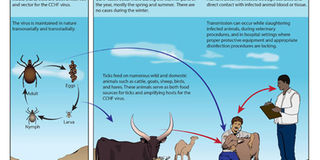Crimean-Congo fever confirmed in Jinja

This graphic illustration by CDC shows the life cycle of the Crimean-Congo haemorrhagic fever virus. Hard ticks are both a reservoir and vector for the CCHF virus. Humans become infected through tick bites and through direct contact with infected animal blood or tissue. The ticks feed on numerous wild and domestic animals, like cattle, goats, sheet and hares. Transmission of the virus can occur during slaughtering of infected animals, during veterinary procedures, and in hospital settings.
What you need to know:
- Jinja District Chairman Titus Kisambira, said 11 suspected cases have been quarantine in their homes in Nakakulwe village, LC 1B.
- According to WHO, the disease is caused by Bunya virus. It is transmitted by tick bites, contact with infected animal blood or tissues, and person-to person transmission via blood, body fluids and semen.
The ministry of health has confirmed a case of Crimean- Congo Hemorrhagic fever and warned of a possible outbreak in Jinja District, eastern Uganda.
“A 32-year-old male, who passed on at Entebbe General Hospital in Wakiso, tested positive with Crimean- Congo Hemorrhagic fever. He was buried in Jinja,” said Ministry of Health spokesperson Emmanuel Ainebyoona.
The deceased was a builder and was staying in Bendegere village, Kasenyi parish-Katabi Sub County in Wakiso District. His body was transported by relatives from Entebbe General Hospital and buried in Butagaya, Nakakulwe village, in Jinja on April 12, 2019.
"This is to alert the general public of Jinja that; there is a suspected outbreak of Crimean-Congo hemorrhagic fever disease following a death of the confirmed case with the disease," read a statement issued by Jinja District Health Officer.
Jinja District Chairman Titus Kisambira, said 11 suspected cases have been quarantine in their homes in Nakakulwe village, LC 1B.
“We have quarantine 11 people, who have shown signs and symptoms of the disease. Some are relatives of the man who died and others participated in his burial,” said Jinja District Chairman Titus Kisambira.
Ministry of Health Spokesperson Emmanuel Ainebyoona, said medical officers are on the ground investigating other suspected cases. “But the public should remain calm as we investigate the illness and report any person with symptoms to the nearest health facility.”
According to WHO, the disease is caused by Bunya virus. It is transmitted by tick bites, contact with infected animal blood or tissues, and person-to person transmission via blood, body fluids and semen.
The symptoms are sudden onset of fever, general body weakness, headache, severe pain in limbs, bloody diarrhea and bleeding from body openings. An outbreak of the Crimean-Congo Hemorrhagic fever has been confirmed in several parts of the country since 2017.
In 2017, the Ministry of Health confirmed an outbreak of the fever in the districts of Nakaseke and Luwero, and in 2018, an outbreak was confirmed in Kabarole District, where it killed one person.




